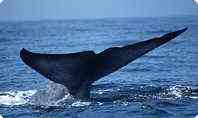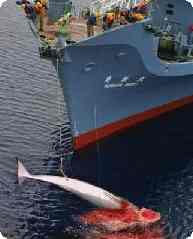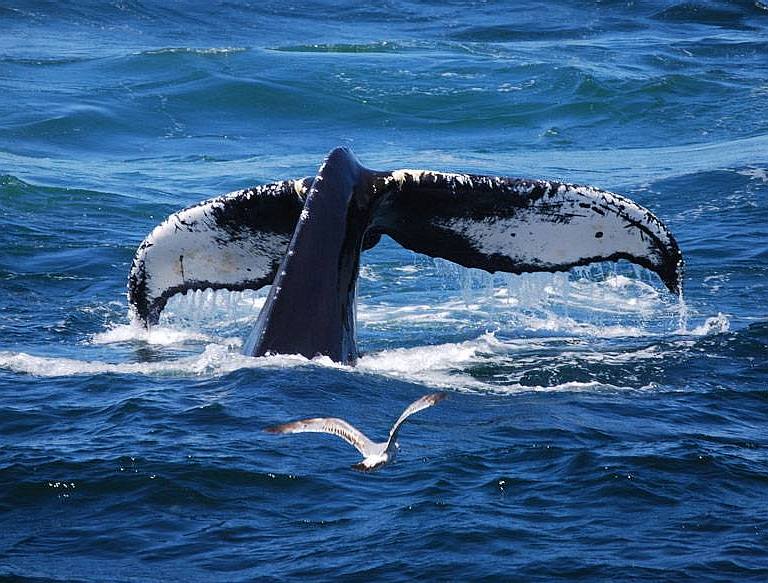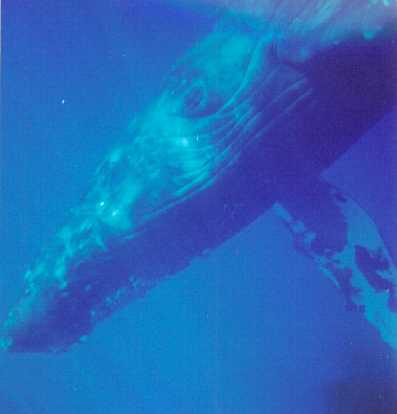|
WHALES DOLPHINS | SHARKS | WHALES
|
|||||||||||||||||||||||||||||||||||||||||||||||||||||
|
Whales and dolphins are a group of mammals called cetaceans that spend their entire lives in water. Today there are around 77 different species of cetaceans, inhabiting our oceans from the cold Antarctic Continent in the south to the Arctic Sea around the North Pole. There are two very different groups of cetaceans: Baleen whales and Toothed whales. Whales and dolphins are among the most intelligent and mysterious creatures on our earth.
THE
BLUE WHALE
Blue Whales Blue Whale Photos The Blue Whale The Animal Diversity Web Baleen Whales A Sea World Education Resource
JAPANESE WHALING SHIP
Members of the order Cetacea vary greatly in size and include the largest animals that have ever lived. Cetaceans never leave the water, even to give birth. Although their ancestry has been much debated, DNA studies and skeletal evidence from extinct early whales indicate that whales evolved from the ancestors of artiodactyls, a group that includes hippopotamuses, cows, pigs, and deer.
Characteristics and Behavior
Like other mammals, whales breathe air, are warm-blooded, and produce milk to feed their young. Their adaptations for aquatic life include a streamlined form, nearly hairless skin, and an insulating layer of blubber, which can be as thick as 28 in. (70 cm) in some Arctic species. The forelimbs of whales are modified into flippers, and the hind legs are reduced to internal vestiges. Many species possess a dorsal fin. The tail is flattened into horizontal flukes and is used for propulsion. The head is very large, with a wide mouth and no external neck.
Whales have one or two nostril openings, called blowholes, located far back on the top of the head; the nostril valves close and the lungs compress when the whale dives. Most whales must surface every 3 to 20 min to breathe, but some, like the sperm whale, can remain submerged for more than an hour. Spouting occurs when the whale surfaces and clears water from its blowhole along with any moisture trapped in its air passages. The shape of the spout is characteristic of each type of large whale. Whales have small eyes, designed to withstand great pressures, and most species have good vision. Their hearing is also excellent. Many cetaceans have highly convoluted brains larger than those of humans, and whales are believed to be extremely intelligent.
Most large whales travel in small schools, or pods, but some, like the fin whale, swim alone or in pairs; small cetaceans form schools of up to several thousand individuals. Most large whales are found in open ocean, where they migrate thousands of miles between feeding and breeding grounds. Dolphins frequently live in coastal waters. A few dolphin species are found in tropical rivers. Females of most species give birth to a single calf every two to three years. Gestation periods range from 9.5 to 17 months. The newborn calf is pushed to the surface by the mother or by another adult; it is able to swim almost immediately and is nursed for 6 to 12 months. Some large whales are believed to have lived 100 years or more in the wild.
Whale song
Types of Whales
There are two major groups of whales—the toothed whales (suborder Odontoceti) and the toothless baleen whales (suborder Mysticeti).
Toothed Whales
Toothed whales include two families that are widely distributed, the beaked and bottlenose whales (family Ziphiidae) and the sperm whale, or cachalot (family Physeteridae); the beluga, or white whale, and the narwhal (family Monodontidae), small polar whales with no dorsal fin and only a few teeth; the river dolphins (family Platanispidae), which inhabit muddy rivers of India and South America; and several families better known as ocean dolphins and porpoises. The killer whale and pilot whale are types of dolphin. The white whale Moby-Dick, of Herman Melville's novel, was not a beluga but a sperm whale with prominent white features.
Toothed whales range in length from 4 to 60 ft (1.3–18.5 m). They catch fast-moving prey, like fish or squid. Many species use echolocation (sonar) for underwater navigation and hunting. They have a single blowhole and a wide throat to accommodate large prey. Some of the larger ones, like the sperm whale, can dive as deep as 1 mi (1.6 km).
Toothless Whales
There are three families of baleen whales: the right whale family (Balaenidae), including the bowhead, or Greenland whale; the gray whale family (Eschrichtidae), with a single species (Eschrichtius robustus) found in the N Pacific Ocean; and the rorqual family (Balaenopteridae). Rorquals, the most familiar of the large whales, have large, pouchlike throats with furrows running from mouth to belly. The family includes the humpback whale, the sei whale, the minke whale, the Bryde's whale, the fin whale (or common rorqual), and the blue whale, which can grow to a length of 100 ft (30 m) and a weight of 150 tons.
Baleen whales are large species, usually over 33 ft (10 m) long. They are filter feeders, living on shrimplike krill, plankton, and small fish. They lack teeth but have brushlike sheets of a horny material called baleen, or whalebone, edging the roof of the mouth. With these strainers and their enormous tongues, tons of food can be separated from seawater. Baleen whales have narrow throats and paired blowholes. Male humpbacks produce a repeated pattern of sounds called a song during the mating season; the purpose is not clear, as all males in a group sing basically the same song. Whaling
All species of large whales have been drastically reduced in numbers by centuries of intensive whaling. An indefinite ban by the International Whaling Commission on commercial whaling of all large whales gradually went into effect following the 1984–85 season, and large portions of ocean have been designated whale sanctuaries. With these and various other protective efforts, some species have begun to return to acceptable numbers, but others, especially the right and blue whales, are still rare and endangered. After decades of protection the number of E Pacific gray whales seems to have returned to its estimated prewhaling level. Only the small minke whale exists in populations great enough for sustainable whaling to be considered. Whale products include whale oil, sperm oil, spermaceti, ambergris, and whalebone, as well as meat, bone meal, and liver oil. Natural and synthetic materials have replaced all whale products in the United States. See separate entry on whaling for more information. Classification
Whales are classified in the phylum Chordata, subphylum Vertebrata, class Mammalia, order Cetacea.
HUMPBACK WHALE
LINKS
Environmentalists hope to save the whales - again
Japan
backs Iceland's whaling decision Seattle Post
Intelligencer -
Greens
dismayed at Iceland whaling decision
Scoop.co.nz (press release), New Zealand -
Iceland
to Resume Commercial Whaling
Los Angeles Times, CA -
Green
warrior to come to Iceland IcelandReview, Iceland -
Today's
Scoop Just Politics News Summary
Update:
Finnair strike expected to continue next week
International Herald Tribune, France -
Tharp She Gets Shot! The Return of Whaling in Iceland
Plenty Magazine, NY -
Whaling
is affecting tourism IcelandReview, Iceland -
Iceland,
Whales, Politics
FiNS Magazine, Singapore -
Iceland
to resume commercial whaling after almost 2
decades
USA Today 17-10-06
Iceland's Whaling Comeback - Preparations for the Resumption of ... The
Whale and Dolphin Conservation Society (WDCS) is the leading
international charity dedicated solely to the worldwide conservation and
welfare of all ... www.wdcs.org/dan/publishing.nsf/
BBC NEWS | Science/Nature | Moves begin on Iceland's whaling Iceland's ambassador to Britain is summoned to explain his country's return to commercial whaling. news.bbc.co.uk/1/hi/sci/tech/6064028.stm
BBC NEWS | Science/Nature | Iceland bids to resume whaling Iceland reveals its plans to catch whales again for the first time since 1989, despite the international whaling moratorium. news.bbc.co.uk/1/hi/sci/tech/2910655.stm
Iceland Whaling v/s Whale watching. Whaling v/s Whale watching. The most commonly used argument in Iceland is that whaling must be resumed before the whales start ... Yearly report on Iceland whale watching industry: ... www.global500.org/news_83.html
My opinion: Iceland's reasons for scientific whaling are FUBAR and if we can ... I wonder how many of you criticising Iceland's whaling have actually read ... weblog.greenpeace.org/iceland/archives/001530.html
Stop Icelandic Whaling: Arctic Sunrise Expedition 2005, Stop Icelandic Whaling: Arctic ... tourism in Iceland IF Iceland discontinues whaling. One Icelandic ... weblog.greenpeace.org/iceland/archives/2003_09.html
Greenpeace 'disappointed' by Iceland's whaling plans. 19/10/2006 Greenpeace
says it is very disappointed Iceland has decided to resume
commercial whaling Iceland has authorised an annual hunt of 30
minke and nine of the ...
Iceland's
whaling proposal threatens its growing whale-watching industry.
In 2002, more than 62000 people went whale-watching in Iceland.
...
Japan backs Iceland's whaling decision - Yahoo! News Major
pro-whaling nation Japan on Wednesday welcomed Iceland's
decision to resume commercial whaling, saying Iceland's
catch won't "endanger the whale ...
Whales on the Net - Iceland Whaling Protest Letter I am appalled to learn that Iceland has decided to resume commercial whaling under the guise of scientific research, and plans to kill 38 minke whales this ... www.whales.org.au/alert/iceletter.html
Solarnavigator is a whale friendly trimaran with an extremely efficient active hull that runs on clean renewable solar power - a boat in harmony with nature.
|
|||||||||||||||||||||||||||||||||||||||||||||||||||||
|
This website is Copyright © 1999 & 2015. The bird logos and name Solar Navigator are trademarks. All rights reserved. All other trademarks are hereby acknowledged. Max Energy Limited is an educational charity working hard for world peace.
|
|||||||||||||||||||||||||||||||||||||||||||||||||||||




